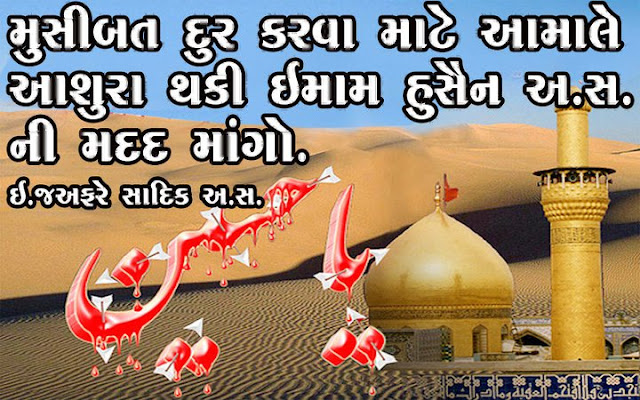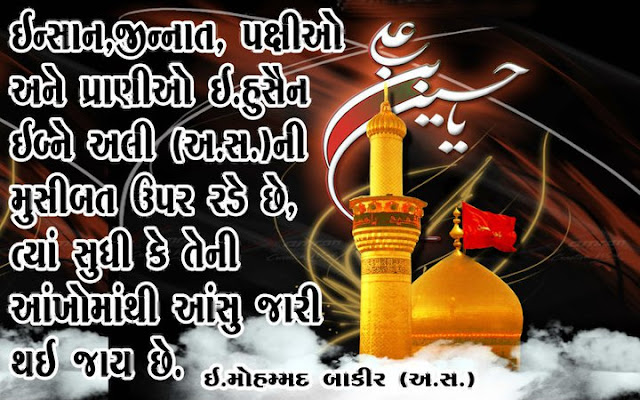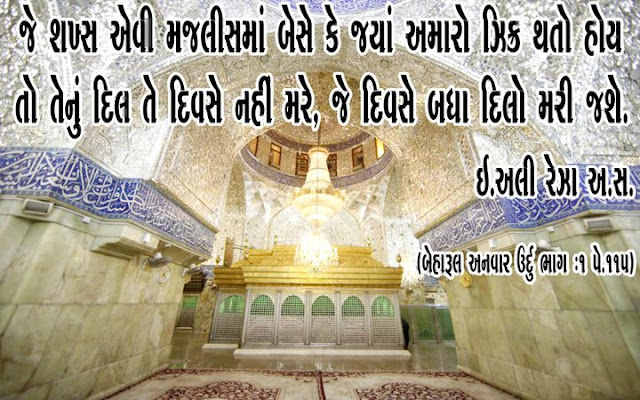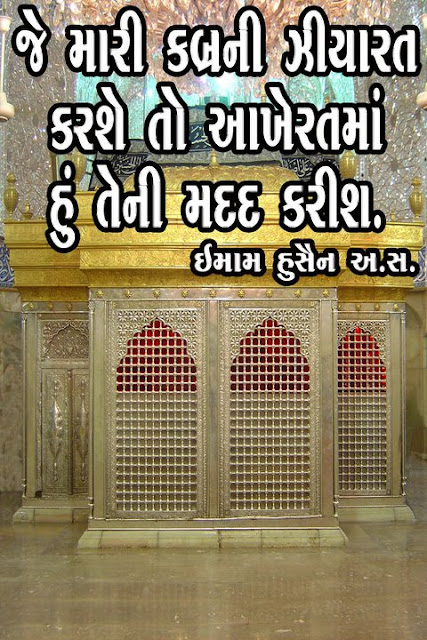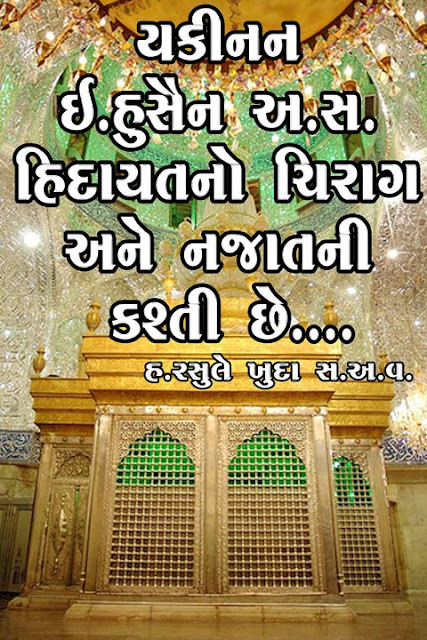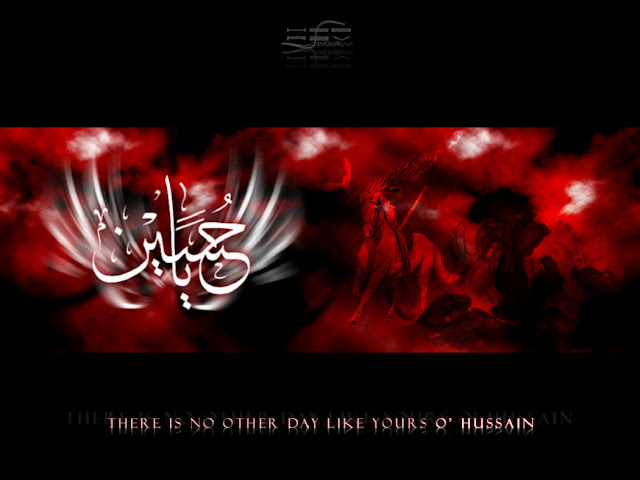Interview with Ayatollah Sayed Hadi Modarresi
 Going To Ziyarah
Going To Ziyarah
Abid Bilgirami sb on Qamazani and Mujtahedeen
Ayatullah Khorasani on Blood letting
Imam Hasan Al-Askari (a.s.) includes the performance of Ziyarat-e-Arba’een as one of the five marks for a believer, in addition to reciting 51 raka of sala, audible recitation of Bismillah, wearing a ring on one’s right hand, and doing sajda on dust. (This hadith has been narrated by Sheikh Tusi in the book Tahthib).
Why is so much importance given to the performance of the Ziyarat of Arba’een and the observance of Arba’een (40 days of mourning)?
Ziyarat, as we all know is a visitation, which in essence, is the act of speaking with and visiting our role models. Of course the physical manifestation of the ziyarat is actually being present in Kerbala to perform the Ziyarat of Arba’een, but, in reality, that is not possible for every believer. So does making ziyarat while not in Kerbala give one the same benefits? Ahadith tell us that performing the Ziyarat of Imam Hussain (a.s.) far from Kerbala would hold the same significance as being in the land of Kerbala, as long as the person performing the Ziyarat has truly understood the status of the Imam and seeks to emulate him.
Imam Muhamed al-Baqir (a.s.) states that the heavens wept over Imam Hussain (a.s.) for forty mornings, rising red and setting red. As we complete 40 days of remembrance of our Imam, we re-assert our pledge of obedience and loyalty to him,
“I bear witness that you are the Imam (who is) the upright, the pious, well-pleased (with Allah), the pure, the guide and the rightly-guided.
I bear witness that you fulfilled the pledge of Allah and you struggled in His way…I am a friend of whoever befriends him ...”
I bear witness that you fulfilled the pledge of Allah and you struggled in His way…I am a friend of whoever befriends him ...”
By performing the Ziyarat of Arba’een, we pledge that we will continue to follow the path of justice and righteousness and will reject injustice and speak up against the oppressors of the time,
I am an enemy of whoever is his enemy
In essence, we make a promise to continue to mold our lives according to the teaching of Imam Hussain (a.s.).
But why is it that we mourn and remember Imam Hussain (a.s.) for a period of forty days and then move on?
Our Prophet has said, “The earth mourns the death of a believer for forty mornings.” Therefore it appears that the deceased should be remembered and mourned over for a period of forty days. Performing an act for a continuous period of forty days is also known to help one to not just form a habit, but also to carry on the practice for the rest of his life.
If we look at studies dealing with bringing a lifestyle change, we notice the time period emphasized to bring about a change is usually 6 weeks which is about the same time period as 40 days (to be exact it is 42 days).
In the book 40 Days to Personal Revolution: A Breakthrough Program to Radically Change Your Body and Awaken the Sacred Within Your Soul, the author Baron Baptiste explains the significance of forty days:
Why forty days? Because the number 40 holds tremendous spiritual significance in the realm of transformation. Jesus wandered in the desert for forty days in order to experience purification and come to a greater understanding of himself and his mission. Moses and his people traveled through the desert for forty years before arriving at their home in the holy land. Noah preserved the sacredness of life by sailing his ark for forty days and forty nights. According to the Kabbalah, the ancient Jewish mystical text, it takes forty days to ingrain any new way of being into our system….
Reciting particular duas for a period of 40 days is highly recommended in our practices as well. The unit 40 (forty) is said to be very effective. If a particular Duaa is recited 40 times, or 40 people gather to recite it, or it is recited for 40 days then its effectiveness is highly increased. (Duas.org)
It is reported from Imam Ja'fer Sadiq (a.s.) that whoever recites Dua-e-Ahad for forty days, after morning prayers will be amongst the helpers of the 12th Imam (a). Visitation of the shrine of Imam Hussain (a.s.) as well as Masjid-e-Sahla for 40 consecutive Thursdays is also very highly recommended and is one of the acts that promises a visit from the 12th Imam (ajtf).
Thus, as we perform the Ziyarat of Arba’een and commemorate the Arba’een, 40 days of mourning of Imam Hussain (a.s.), we hope and pray that this forty days of remembrance of Imam Hussain (a.s.), brings about a transformation in us by which we can continue to follow the path of Imam Hussain (a.s.) and carry on his message of upholding justice with true faith and a strong sense of sacrifice!
Refs:
A’maal of Muharram and Safar (Tayyiba Publishers)
Kerbala and Beyond by Yasin T. Al-Jabouri
The Miracle of Ziyarat-e-Ashoora
Commentary on Ziyarat Ashura, translated by Saleem Bhimji from the work of Ali Asghar Azizi Tehrani
Kitab al-Irshad, translated by IKA Howard, authored by Sheikh Al-Mufeed
A’maal of Muharram and Safar (Tayyiba Publishers)
Kerbala and Beyond by Yasin T. Al-Jabouri
The Miracle of Ziyarat-e-Ashoora
Commentary on Ziyarat Ashura, translated by Saleem Bhimji from the work of Ali Asghar Azizi Tehrani
Kitab al-Irshad, translated by IKA Howard, authored by Sheikh Al-Mufeed
Why Arba'een? Significance of Arba'een and the Performance of the Ziyarat of Arba'een
Posted at 10:20 PM | in Azadari
|
Read More»
Imam Hasan Al-Askari (a.s.) includes the performance of Ziyarat-e-Arba’een as one of the five marks for a believer, in addition to reciting 51 raka of sala, audible recitation of Bismillah, wearing a ring on one’s right hand, and doing sajda on dust. (This hadith has been narrated by Sheikh Tusi in the book Tahthib).
Why is so much importance given to the performance of the Ziyarat of Arba’een and the observance of Arba’een (40 days of mourning)?
Ziyarat, as we all know is a visitation, which in essence, is the act of speaking with and visiting our role models. Of course the physical manifestation of the ziyarat is actually being present in Kerbala to perform the Ziyarat of Arba’een, but, in reality, that is not possible for every believer. So does making ziyarat while not in Kerbala give one the same benefits? Ahadith tell us that performing the Ziyarat of Imam Hussain (a.s.) far from Kerbala would hold the same significance as being in the land of Kerbala, as long as the person performing the Ziyarat has truly understood the status of the Imam and seeks to emulate him.
Imam Muhamed al-Baqir (a.s.) states that the heavens wept over Imam Hussain (a.s.) for forty mornings, rising red and setting red. As we complete 40 days of remembrance of our Imam, we re-assert our pledge of obedience and loyalty to him,
“I bear witness that you are the Imam (who is) the upright, the pious, well-pleased (with Allah), the pure, the guide and the rightly-guided.
I bear witness that you fulfilled the pledge of Allah and you struggled in His way…I am a friend of whoever befriends him ...”
I bear witness that you fulfilled the pledge of Allah and you struggled in His way…I am a friend of whoever befriends him ...”
By performing the Ziyarat of Arba’een, we pledge that we will continue to follow the path of justice and righteousness and will reject injustice and speak up against the oppressors of the time,
I am an enemy of whoever is his enemy
In essence, we make a promise to continue to mold our lives according to the teaching of Imam Hussain (a.s.).
But why is it that we mourn and remember Imam Hussain (a.s.) for a period of forty days and then move on?
Our Prophet has said, “The earth mourns the death of a believer for forty mornings.” Therefore it appears that the deceased should be remembered and mourned over for a period of forty days. Performing an act for a continuous period of forty days is also known to help one to not just form a habit, but also to carry on the practice for the rest of his life.
If we look at studies dealing with bringing a lifestyle change, we notice the time period emphasized to bring about a change is usually 6 weeks which is about the same time period as 40 days (to be exact it is 42 days).
In the book 40 Days to Personal Revolution: A Breakthrough Program to Radically Change Your Body and Awaken the Sacred Within Your Soul, the author Baron Baptiste explains the significance of forty days:
Why forty days? Because the number 40 holds tremendous spiritual significance in the realm of transformation. Jesus wandered in the desert for forty days in order to experience purification and come to a greater understanding of himself and his mission. Moses and his people traveled through the desert for forty years before arriving at their home in the holy land. Noah preserved the sacredness of life by sailing his ark for forty days and forty nights. According to the Kabbalah, the ancient Jewish mystical text, it takes forty days to ingrain any new way of being into our system….
Reciting particular duas for a period of 40 days is highly recommended in our practices as well. The unit 40 (forty) is said to be very effective. If a particular Duaa is recited 40 times, or 40 people gather to recite it, or it is recited for 40 days then its effectiveness is highly increased. (Duas.org)
It is reported from Imam Ja'fer Sadiq (a.s.) that whoever recites Dua-e-Ahad for forty days, after morning prayers will be amongst the helpers of the 12th Imam (a). Visitation of the shrine of Imam Hussain (a.s.) as well as Masjid-e-Sahla for 40 consecutive Thursdays is also very highly recommended and is one of the acts that promises a visit from the 12th Imam (ajtf).
Thus, as we perform the Ziyarat of Arba’een and commemorate the Arba’een, 40 days of mourning of Imam Hussain (a.s.), we hope and pray that this forty days of remembrance of Imam Hussain (a.s.), brings about a transformation in us by which we can continue to follow the path of Imam Hussain (a.s.) and carry on his message of upholding justice with true faith and a strong sense of sacrifice!
Refs:
A’maal of Muharram and Safar (Tayyiba Publishers)
Kerbala and Beyond by Yasin T. Al-Jabouri
The Miracle of Ziyarat-e-Ashoora
Commentary on Ziyarat Ashura, translated by Saleem Bhimji from the work of Ali Asghar Azizi Tehrani
Kitab al-Irshad, translated by IKA Howard, authored by Sheikh Al-Mufeed
A’maal of Muharram and Safar (Tayyiba Publishers)
Kerbala and Beyond by Yasin T. Al-Jabouri
The Miracle of Ziyarat-e-Ashoora
Commentary on Ziyarat Ashura, translated by Saleem Bhimji from the work of Ali Asghar Azizi Tehrani
Kitab al-Irshad, translated by IKA Howard, authored by Sheikh Al-Mufeed
Salamun alaykum, The reply to the previous question on Zanjeer Ma'tam is reposted here with the actual text of the rulings of various Mujtahid on this and other aspect of the Azadari. The rulings were kindly provided by Mullah Asghar. Mustafa Rawji Acting Moderator, ABDG-A QUESTION: According to the Mujtahideens of our religion, What is the mutual consent over the issue of Zanjeer Ma'tam which is a kind of ma'tam ,in which backs of men in Pakistan, India and Lebanon are cut and bleed? Is it permissible or forbidden? Are fatwas available or a documented reference to where I could find such fatwas? I would really like the authentic proof of evidence since I have heard both sides with regards to it's permissibility. ANSWER: In Iran, India and Pakistan, many books citing the opinions of previous Mujtahideen on this issue have been printed over the years. The consensus of the majority (although not all) of them is that it is permissible. I have seen one such book where the fatawa of great Ulema such as Mirza Husein Na'ini, Agha Ziyauddin Iraqi, Agha Muhsin al-Hakim, Agha Abul Qasim al-Khui and some others have been printed, allowing it. Wasalaam, Asgharali M M Jaffer REFERENCE: ------> From "Azadari Az Deedgah Marjaiyyate Shi'a" (Azadari in the view of the Shia Maraje) compiled by Ali Rabbani Khalkhali, printed by Waliye 'Asr Trust, Pakistan. The people of Basrah had forwarded certain questions telegraphically to the late Marja, Raeesul Fuqaha, Sheikh Muhammad Husain Naeni (RA). He gave the following answer: In the name of Allah, Most Merciful. To the people of Basrah and its surroundings: After salutations and greeting to the respected people of Basrah and its suburbs: We have received your several letters and telegrams asking us to give our ruling on the matter of processions which are taken out to mourn and grieve the martyrs of Kerbala, and on other aspects relevant to them. As we have returned safely to Najaf, all praise to Allah, we write the answer to those questions by clarifying the following points: First, taking out the mourning procession on the day of Ashura and other similar occasions, on the streets and public roads is undoubtedly permissible, and is a matter of preference. It is one of the best manifestations of our mourning and grief for the oppressed martyrs, and the best way of propagating the Husaini Mission far and wide. However, it is imperative that in such acts of reverence, people refrain from improper practices like music or use of its instruments or engaging in undue competition and rivalry and things like that. And if such practices occur, they would be deemed haram, though it does not in any way affect the procession itself. It is just like someone who stares at Na-Mahram while he is praying. The act will be a forbidden one but the prayers are not thereby invalidated. Secondly, there is no objection to beating cheeks and chest till they show redness or blackness. It is also permitted to hit one's back with chains to that extent, or, even if a little blood comes out. As to hitting one's front part of the head with the sword, it is allowed if it does not entail extraordinary danger. It should be confined bleeding, without harming the skull bones, nor causing excessive bleeding, the same way as experienced and trained people do. However, if one does it carefully, yet inadvertently harms himself by excessive bleeding, that would be a forbidden act, like one who did Wudhu, Ghusl or kept a fast believing that it was safe for him and then it turned out to be harmful. However, it is better, in fact Ahwat that only experienced and trained people engage in such acts. The youths who in their intense grief, love and emotions for Imam Husain (AS) exceed the limit and as a result carelessly harm themselves, should refrain from such acts. May Allah keep them steadfast on the right path, in this world and hereafter. Thirdly, apparently there is no objection to bringing out symbols, semblances and other illustration Shabeeh, as has been customary among the Imamiya Shias during the last several centuries, even if it involves men wearing women's dress. This is done with the purpose of inciting sorrow and grief. Though we had earlier hesitated about men wearing women's dress and had put in some limitations on the matter of shabeeh in our Fatwa issued four years ago, but we have revised our view. On second thought, we are convinced that it is haram for a man to wear women's dress, by adopting it as a permanent mode of dress. But if it is worn for a brief occasion without adopting it as an attire, the way it is done during these shabeeh, it is not objectionable. We have added this to our latest notes on al-Urwah al-Wuthqa. Yes it is necessary that people refrain from committing acts which are forbidden though I have mentioned earlier that it would not affect the practice of bringing out shabeeh. Fourth, the drums which are used in such processions, (though we have not been able to investigate its significance) are also permissible if they are meant for mourning, or calling people to assemble or to warn those who are mounted, or to rhyme with the shouts and clamour which is traditional among Arabs and provided that they are not used for rejoicing or amusement. Allah knows best. Rabiul Awwal 1345 A.H. Muhammed Husain al-Ghavawi al-Naeni. 2. The views expressed by Ayatullah al Udhama Aga Syed Muhsin al Hakim Taba Tabai (RA) on the above Fatwa. In the name of Allah, the Merciful and Forgiving. The subject matter elucidated by our great master is succinct, and has extreme clarity. In fact it is so clear that it hardly needs any supplementary Fatwa to support it further. It is felt that certain criticisms have been levelled against acts which are contrary to the spirit of Azadari and expression of grief toward Imam Husain b. Ali (AS). It is incumbent upon Mu'mineen to try and refrain from such practices which give occasion for criticism to the enemies of Imam Husain (AS). It is absolutely necessary to perpetuate the grief and weeping over the great tragedy and to help the continuity of these sacred signs. May Allah bless us with His Guidance. Upon Him we depend, and unto Him we return. 2nd Muharram 1367 A.H. Muhsin al Taba Tabai al Hakim 3. The view expressed by Ayatullah al Udhama Aga Syed Abul Qasim al Khui (RA) In the name of Allah, Most High. The answers given by our master, to the questions put forward by the people of Basrah, are correct, and it is permissible to act accordingly. And we pray to Allah to guide all Mu'mineen to venerate and respect the religious symbols, and to refrain from such acts which are forbidden. Abul Qasim al Musavi al Khui.
Zanjeer Matam - al-islam.org
Posted at 3:51 AM | in Azadari
|
Read More»
Salamun alaykum, The reply to the previous question on Zanjeer Ma'tam is reposted here with the actual text of the rulings of various Mujtahid on this and other aspect of the Azadari. The rulings were kindly provided by Mullah Asghar. Mustafa Rawji Acting Moderator, ABDG-A QUESTION: According to the Mujtahideens of our religion, What is the mutual consent over the issue of Zanjeer Ma'tam which is a kind of ma'tam ,in which backs of men in Pakistan, India and Lebanon are cut and bleed? Is it permissible or forbidden? Are fatwas available or a documented reference to where I could find such fatwas? I would really like the authentic proof of evidence since I have heard both sides with regards to it's permissibility. ANSWER: In Iran, India and Pakistan, many books citing the opinions of previous Mujtahideen on this issue have been printed over the years. The consensus of the majority (although not all) of them is that it is permissible. I have seen one such book where the fatawa of great Ulema such as Mirza Husein Na'ini, Agha Ziyauddin Iraqi, Agha Muhsin al-Hakim, Agha Abul Qasim al-Khui and some others have been printed, allowing it. Wasalaam, Asgharali M M Jaffer REFERENCE: ------> From "Azadari Az Deedgah Marjaiyyate Shi'a" (Azadari in the view of the Shia Maraje) compiled by Ali Rabbani Khalkhali, printed by Waliye 'Asr Trust, Pakistan. The people of Basrah had forwarded certain questions telegraphically to the late Marja, Raeesul Fuqaha, Sheikh Muhammad Husain Naeni (RA). He gave the following answer: In the name of Allah, Most Merciful. To the people of Basrah and its surroundings: After salutations and greeting to the respected people of Basrah and its suburbs: We have received your several letters and telegrams asking us to give our ruling on the matter of processions which are taken out to mourn and grieve the martyrs of Kerbala, and on other aspects relevant to them. As we have returned safely to Najaf, all praise to Allah, we write the answer to those questions by clarifying the following points: First, taking out the mourning procession on the day of Ashura and other similar occasions, on the streets and public roads is undoubtedly permissible, and is a matter of preference. It is one of the best manifestations of our mourning and grief for the oppressed martyrs, and the best way of propagating the Husaini Mission far and wide. However, it is imperative that in such acts of reverence, people refrain from improper practices like music or use of its instruments or engaging in undue competition and rivalry and things like that. And if such practices occur, they would be deemed haram, though it does not in any way affect the procession itself. It is just like someone who stares at Na-Mahram while he is praying. The act will be a forbidden one but the prayers are not thereby invalidated. Secondly, there is no objection to beating cheeks and chest till they show redness or blackness. It is also permitted to hit one's back with chains to that extent, or, even if a little blood comes out. As to hitting one's front part of the head with the sword, it is allowed if it does not entail extraordinary danger. It should be confined bleeding, without harming the skull bones, nor causing excessive bleeding, the same way as experienced and trained people do. However, if one does it carefully, yet inadvertently harms himself by excessive bleeding, that would be a forbidden act, like one who did Wudhu, Ghusl or kept a fast believing that it was safe for him and then it turned out to be harmful. However, it is better, in fact Ahwat that only experienced and trained people engage in such acts. The youths who in their intense grief, love and emotions for Imam Husain (AS) exceed the limit and as a result carelessly harm themselves, should refrain from such acts. May Allah keep them steadfast on the right path, in this world and hereafter. Thirdly, apparently there is no objection to bringing out symbols, semblances and other illustration Shabeeh, as has been customary among the Imamiya Shias during the last several centuries, even if it involves men wearing women's dress. This is done with the purpose of inciting sorrow and grief. Though we had earlier hesitated about men wearing women's dress and had put in some limitations on the matter of shabeeh in our Fatwa issued four years ago, but we have revised our view. On second thought, we are convinced that it is haram for a man to wear women's dress, by adopting it as a permanent mode of dress. But if it is worn for a brief occasion without adopting it as an attire, the way it is done during these shabeeh, it is not objectionable. We have added this to our latest notes on al-Urwah al-Wuthqa. Yes it is necessary that people refrain from committing acts which are forbidden though I have mentioned earlier that it would not affect the practice of bringing out shabeeh. Fourth, the drums which are used in such processions, (though we have not been able to investigate its significance) are also permissible if they are meant for mourning, or calling people to assemble or to warn those who are mounted, or to rhyme with the shouts and clamour which is traditional among Arabs and provided that they are not used for rejoicing or amusement. Allah knows best. Rabiul Awwal 1345 A.H. Muhammed Husain al-Ghavawi al-Naeni. 2. The views expressed by Ayatullah al Udhama Aga Syed Muhsin al Hakim Taba Tabai (RA) on the above Fatwa. In the name of Allah, the Merciful and Forgiving. The subject matter elucidated by our great master is succinct, and has extreme clarity. In fact it is so clear that it hardly needs any supplementary Fatwa to support it further. It is felt that certain criticisms have been levelled against acts which are contrary to the spirit of Azadari and expression of grief toward Imam Husain b. Ali (AS). It is incumbent upon Mu'mineen to try and refrain from such practices which give occasion for criticism to the enemies of Imam Husain (AS). It is absolutely necessary to perpetuate the grief and weeping over the great tragedy and to help the continuity of these sacred signs. May Allah bless us with His Guidance. Upon Him we depend, and unto Him we return. 2nd Muharram 1367 A.H. Muhsin al Taba Tabai al Hakim 3. The view expressed by Ayatullah al Udhama Aga Syed Abul Qasim al Khui (RA) In the name of Allah, Most High. The answers given by our master, to the questions put forward by the people of Basrah, are correct, and it is permissible to act accordingly. And we pray to Allah to guide all Mu'mineen to venerate and respect the religious symbols, and to refrain from such acts which are forbidden. Abul Qasim al Musavi al Khui.

Q1) is azadari wajib or mustahab?
A1) If there is a chance that shiism will be wiped out by not doing azadari, in such cases azadari becomes wajib, otherwise it is a source of great recompense.
Q2) what is the importance of azadari?
A2) Azadari includes all works whether action or speech which are mubah(ie not haram). It should be done with the aim of spreading word about the oppression of Imam Husain(a) and other ahl Bayt(a) and the humiliation of their enemies. We have been ordered to do azadari, it brings great recompense.
Q3) During azadari of Imam Husain(a), is it allowed to kiss the alam, taziah, zuljinah?
A3) It is not a problem to kiss, it is allowed. But to believe that an infallible(masoom) has ordered to kiss is not allowed.
Q4) what do you say to the wearing of chains on the wrists and the ankles.
A4) If one wears so as not to forget the imprisonment of his oppressed and innocent Imam(a), it is allowed. But to do so thinking it to be the sunnat of the Imam is not allowed. No masoom has ever ordered such a thing.
Q5) Is it allowed to ‘de-shirt’ oneself on the streets to do matam, where women are also present?
A5) It is not a problem, women should not go to such places.
Q6) What is your opinion about zanjeer and kama’
A6) If zanjeer and kama’ are done with the intention of spreading word about the oppression to which Imam Husain(a) was subjected, not only is it allowed but brings great recompense. However, if before doing such matam, one is satisfied (itminan) that he will die or some organ of his body will become useless, it is not allowed. Similarly, it is not allowed in those areas where people, due to ignorance, will turn away from Islam or will feel a revulsion towards Islam.
Q7) While mourning for ImamHusain(a) is it allowed to hit with a dagger or knife, which results in loss of a lot of blood. Is this a source of any recompense? While doing so, if a person dies, what is your opinion regarding this?
A7) If matam is done this way to spread word about the oppression of Imam Husain(a), then it is a source of great recompense. If one dies during this, he will be included amongst the helpers of Imam(a) and the ahl bayt(a) But if he knows before doing such matam that he will die or some part of his body will become useless, it is not allowed. Similarly, do not do such matam in places where ignorant people will turn away from Islam.
Translation of QA paper in urdu handed over by Aytullah Bashir Najafi office in dec 07
Posted at 6:10 AM | in urdu
|
Read More»

Q1) is azadari wajib or mustahab?
A1) If there is a chance that shiism will be wiped out by not doing azadari, in such cases azadari becomes wajib, otherwise it is a source of great recompense.
Q2) what is the importance of azadari?
A2) Azadari includes all works whether action or speech which are mubah(ie not haram). It should be done with the aim of spreading word about the oppression of Imam Husain(a) and other ahl Bayt(a) and the humiliation of their enemies. We have been ordered to do azadari, it brings great recompense.
Q3) During azadari of Imam Husain(a), is it allowed to kiss the alam, taziah, zuljinah?
A3) It is not a problem to kiss, it is allowed. But to believe that an infallible(masoom) has ordered to kiss is not allowed.
Q4) what do you say to the wearing of chains on the wrists and the ankles.
A4) If one wears so as not to forget the imprisonment of his oppressed and innocent Imam(a), it is allowed. But to do so thinking it to be the sunnat of the Imam is not allowed. No masoom has ever ordered such a thing.
Q5) Is it allowed to ‘de-shirt’ oneself on the streets to do matam, where women are also present?
A5) It is not a problem, women should not go to such places.
Q6) What is your opinion about zanjeer and kama’
A6) If zanjeer and kama’ are done with the intention of spreading word about the oppression to which Imam Husain(a) was subjected, not only is it allowed but brings great recompense. However, if before doing such matam, one is satisfied (itminan) that he will die or some organ of his body will become useless, it is not allowed. Similarly, it is not allowed in those areas where people, due to ignorance, will turn away from Islam or will feel a revulsion towards Islam.
Q7) While mourning for ImamHusain(a) is it allowed to hit with a dagger or knife, which results in loss of a lot of blood. Is this a source of any recompense? While doing so, if a person dies, what is your opinion regarding this?
A7) If matam is done this way to spread word about the oppression of Imam Husain(a), then it is a source of great recompense. If one dies during this, he will be included amongst the helpers of Imam(a) and the ahl bayt(a) But if he knows before doing such matam that he will die or some part of his body will become useless, it is not allowed. Similarly, do not do such matam in places where ignorant people will turn away from Islam.
- Create and distribute Ashura ribbons to create an awareness
- If you get a chance to give a speech, include in it the sacrifice of Imam Hussain(as) and give the bigger picture of the purpose of the sacrifice.
- Give out pamphlets on the message of Ashura which are simple and clear and could be understood by one who has no knowledge of the religion of Islam or Shiism.
- Water bottle distribution on the day of Ashura. Stick paper on the water bottles with a saying of Imam Hussain (as) which reflects his wisdom.
- Fight the misconceptions spread by the 'so called muslims' by following the example of Imam Hussain (as), may it be by the way of writings, artwork, discussions etc.
- Tell the story of our Imam in a manner which others can relate to given the present circumstances.
- Organize Hussain Day at your center and invite other Muslims and non-Muslims to it.
- The true mourning of Imam Hussain(as) has to be from the heart; if the heart is mourning, no one would have to tell us what to do or how to behave.
- Organize mourning sessions (Majaalis) on the difficulties Imam Husain (a.s) faced. Shedding tears on Imam (a.s) is pious and great act.
May Allah hasten the reappearance of Imam Mahdi(a.t.f.s), who will take revenge of Martyrs of #Karbala.
Muharram Campaign - Banners (Gujarati & English)
Posted at 1:51 AM | in urdu
|
Read More»
- Create and distribute Ashura ribbons to create an awareness
- If you get a chance to give a speech, include in it the sacrifice of Imam Hussain(as) and give the bigger picture of the purpose of the sacrifice.
- Give out pamphlets on the message of Ashura which are simple and clear and could be understood by one who has no knowledge of the religion of Islam or Shiism.
- Water bottle distribution on the day of Ashura. Stick paper on the water bottles with a saying of Imam Hussain (as) which reflects his wisdom.
- Fight the misconceptions spread by the 'so called muslims' by following the example of Imam Hussain (as), may it be by the way of writings, artwork, discussions etc.
- Tell the story of our Imam in a manner which others can relate to given the present circumstances.
- Organize Hussain Day at your center and invite other Muslims and non-Muslims to it.
- The true mourning of Imam Hussain(as) has to be from the heart; if the heart is mourning, no one would have to tell us what to do or how to behave.
- Organize mourning sessions (Majaalis) on the difficulties Imam Husain (a.s) faced. Shedding tears on Imam (a.s) is pious and great act.
May Allah hasten the reappearance of Imam Mahdi(a.t.f.s), who will take revenge of Martyrs of #Karbala.
Most Viewed
-
 Wallpapers on Shahzadi Fatema (s.a.)-
Wallpapers on Shahzadi Fatema (s.a.)-
-
 Ash'aar - Shahadat Bibi Fatima S.A -
Ash'aar - Shahadat Bibi Fatima S.A -
-
Video: Nadeem Karbalayi Vol-1 1434 AH {2012-13} Title - Noor O Aini Husain a.s. PROMO
-
Zyarate Huasin(a.s.), Qamazani & Mujtahedeen By Abid Bilgirami sb
-
 Muharram Banners - 2017 (For Print)
Muharram Banners - 2017 (For Print)
-
 Translation of QA paper in urdu handed over by Aytullah Bashir Najafi office in dec 07
Translation of QA paper in urdu handed over by Aytullah Bashir Najafi office in dec 07
-
 Muharram Campaign - Banners (Gujarati & English)
Muharram Campaign - Banners (Gujarati & English)
-
The Role of Poetry and Marsiya in Azadari - Maulana Syed Muhammad Rizvi
-
 "dont listen to those who say '' tatbir ,zanjir beating your chest is haram''
"dont listen to those who say '' tatbir ,zanjir beating your chest is haram''
-
URDU: Zanjeer zani & Blood donate - Aga Nasir Mahdevi; Vakil Of Ayatullah Sistani




































